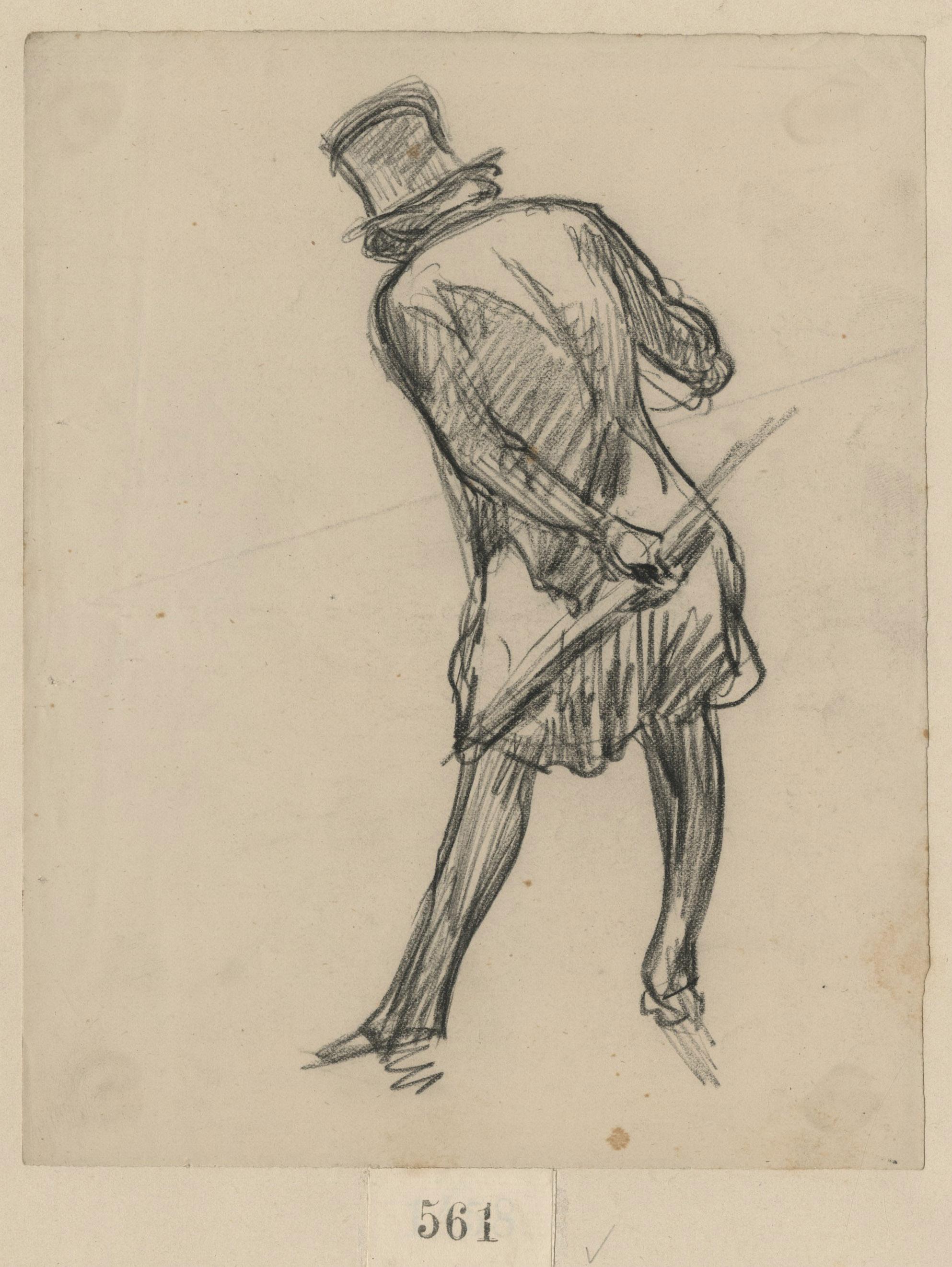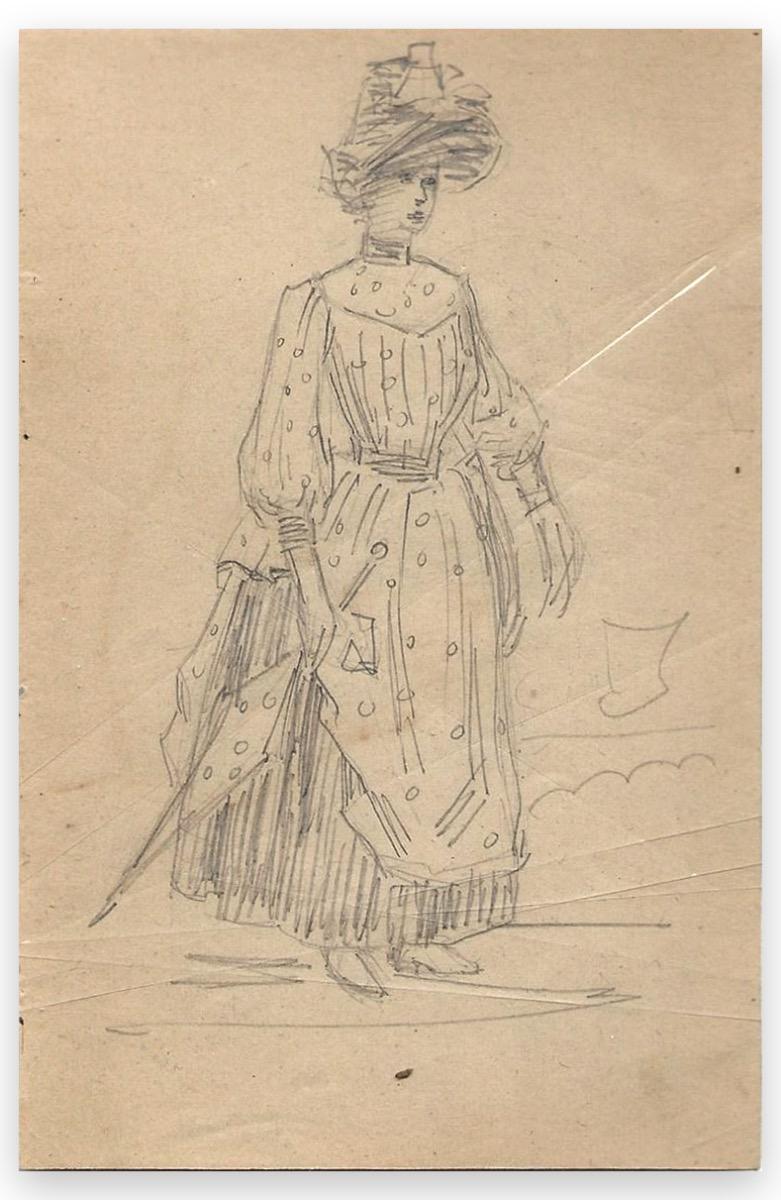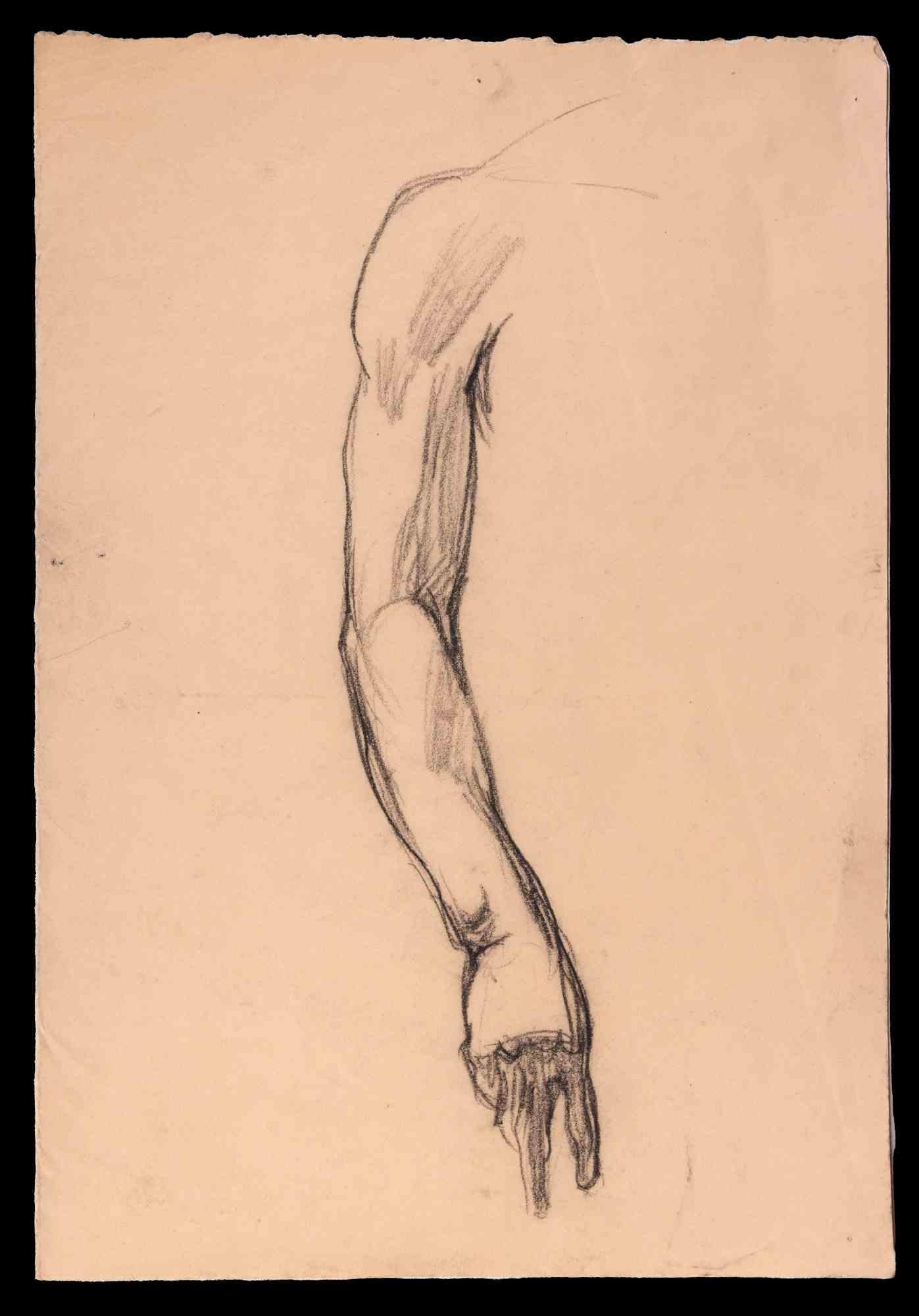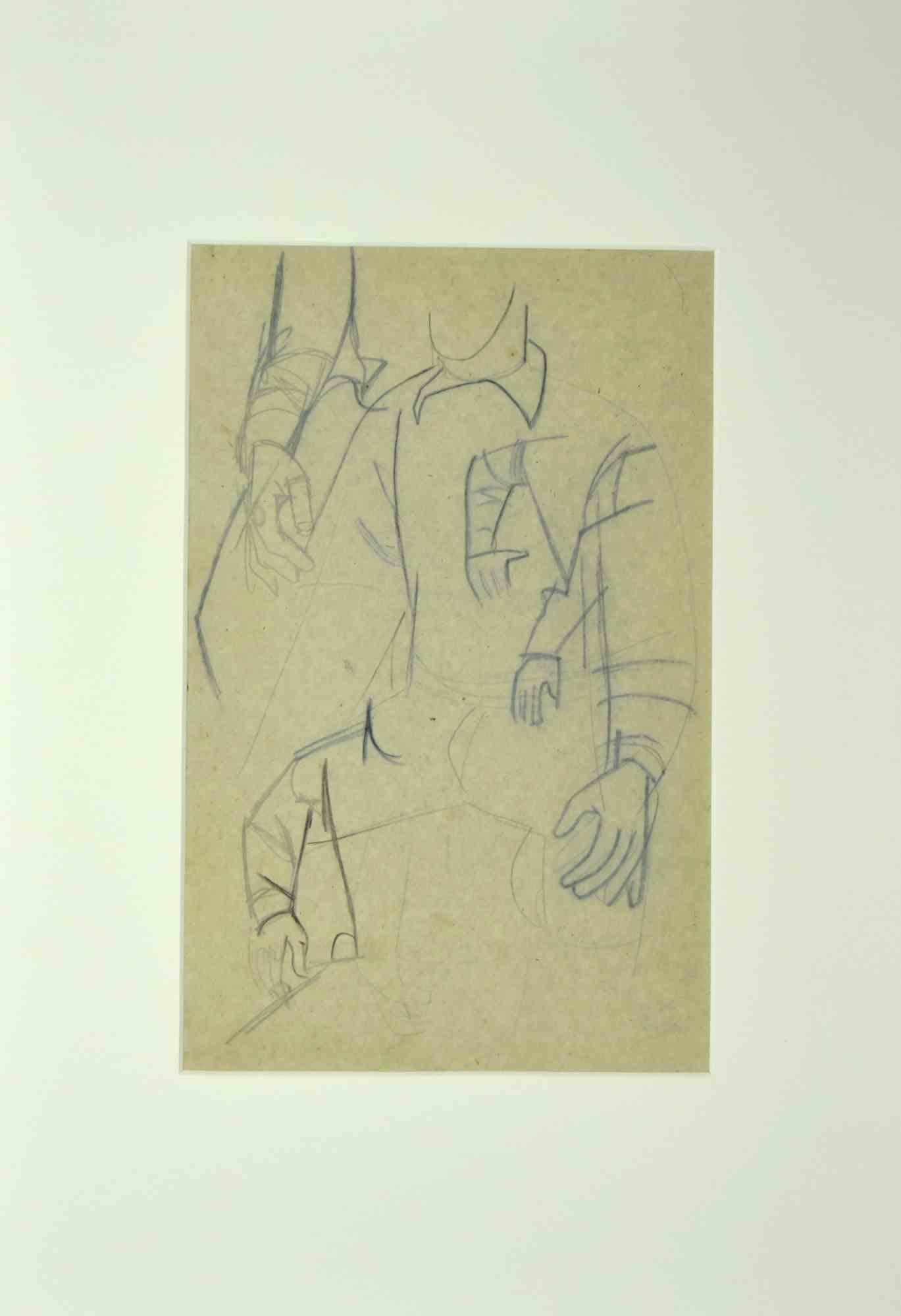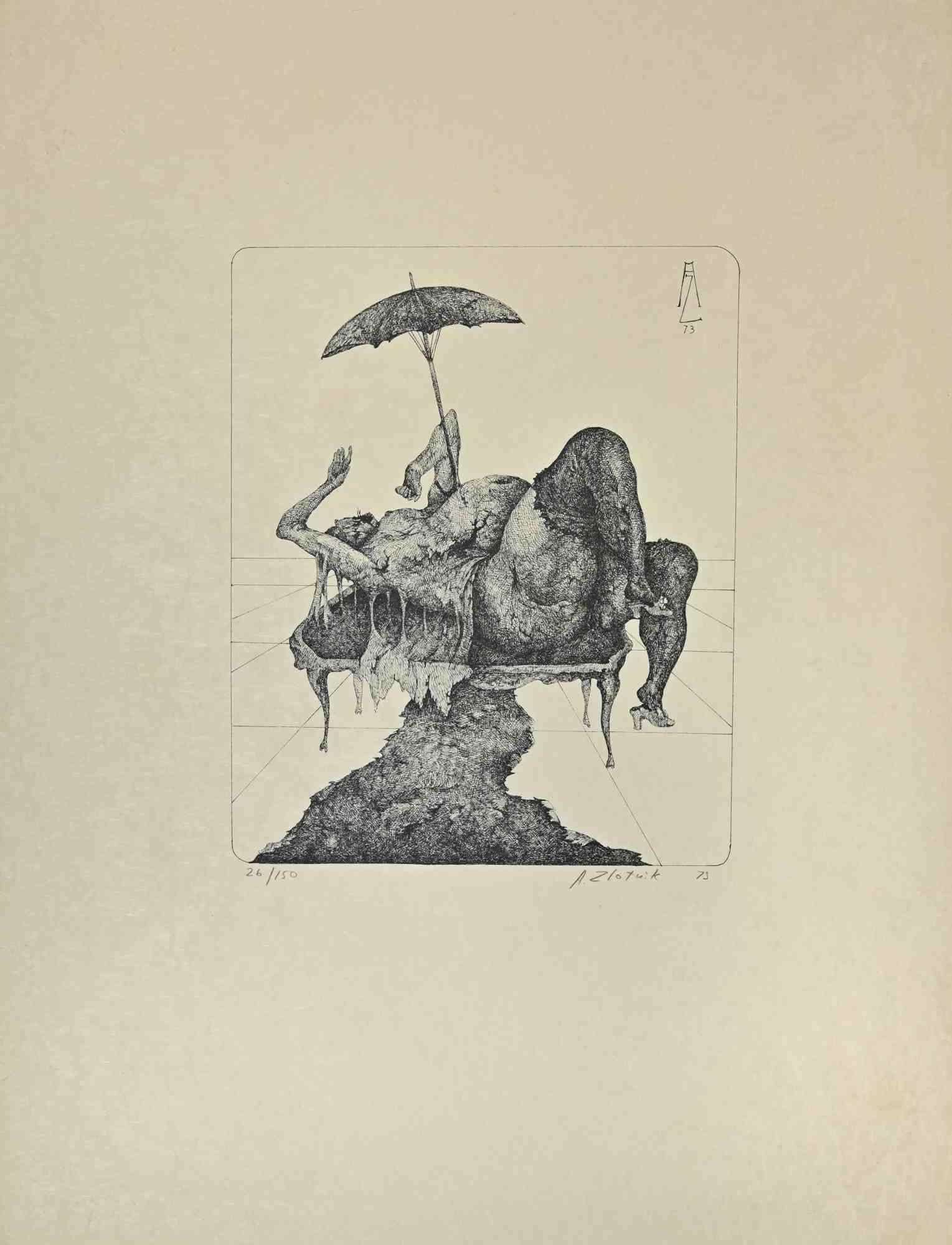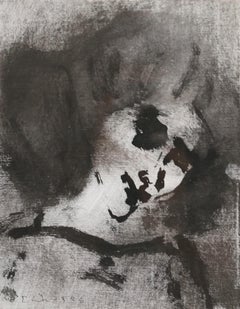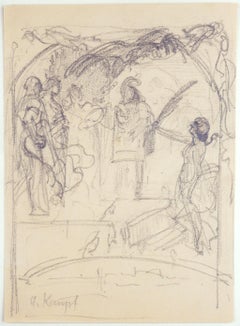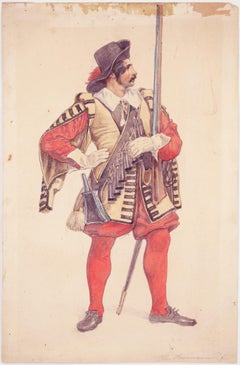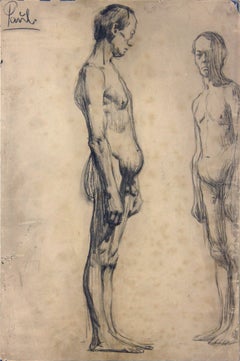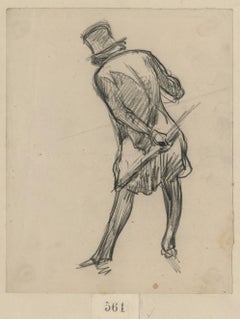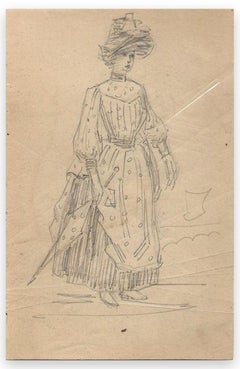Items Similar to Study with Torso, Hands, and Umbrella - The characteristic of the inconspicuous
Want more images or videos?
Request additional images or videos from the seller
1 of 5
Paul MeyerheimStudy with Torso, Hands, and Umbrella - The characteristic of the inconspicuousc. 1890
c. 1890
$529.84
$662.3020% Off
£392.02
£490.0220% Off
€440
€55020% Off
CA$732.60
CA$915.7520% Off
A$804.30
A$1,005.3820% Off
CHF 419.61
CHF 524.5120% Off
MX$9,733.20
MX$12,166.5020% Off
NOK 5,259.13
NOK 6,573.9120% Off
SEK 4,955.48
SEK 6,194.3520% Off
DKK 3,350.17
DKK 4,187.7220% Off
About the Item
Paul Friedrich Meyerheim (1842 Berlin - 1915 ibid.). Sketch of a female torso with hands and an umbrella. Pencil on paper, 27.5 x 22.5 cm (visible size), 23 x 29 cm (sheet), 44.5 x 34.5 cm (mount), inscribed with the signature "Paul Meyerheim Nachlass" at lower right.
- somewhat stained and with light crease marks
- The characteristic of the inconspicuous -
About the artwork
Like his close friend and mentor Adolph von Menzel, Paul Meyerheim, who was a generation younger, was a precise and equally humorous observer of everyday life. Both often captured seemingly insignificant things that, when artistically rendered, revealed their characteristics for society and the general human condition. Menzel pursued the realism initiated by Daniel Nikolaus Chodowiecki in Berlin of preserving and emphasizing the characteristic in the details of everyday life in a straightforwardly exaggerated manner, which was also practiced by Meyerheim.
The present print is a prime example of the observation of such banalities. We see a lady screwing a decorative knob onto the top of a parasol. Although the lady's body is realistically sculpted and placed in the sunlight through the skillful use of light and shadow, the head and lower body are not included. The result is a concentration on the action shown, which also gains an independence through the omission of the only implied head. The action is not characteristic of a particular person, but will be performed in this or a similar way by any lady with such a problem. The method of representation alone transforms the characteristic particular into something general.
When we see the action taking place in front of the lady's torso, Meyerheim has only depicted the action as such in front of this scenery. By zooming in, the performing hands seem to float before the viewer's eyes. They seem to be performing a kind of magic, in which the fingers of one hand elegantly handle the ball of the pommel. In this casual, entirely purposeful action, the elegance and skill of the ladies is shown, as well as the human need to protect oneself from the sun with a shady umbrella.
About the artist
Paul Meyerheim was born into a family of artists. His father, Friedrich Eduard Meyerheim, was a painter, as were his uncles Hermann and Wilhelm, while his mother, Caroline Friederike, was the brother of the sculptor Friedrich Drake.
After receiving his first art lessons from his father, Paul Meyerheim studied at the Berlin Academy of Arts from 1857 to 1860, where he was strongly influenced by the animal painter Teutwart Schmitson. At the age of 18, Meyerheim began exhibiting at the Great Berlin Art Exhibition in 1860, which brought him recognition as an artist. His international breakthrough came when he won the gold medal at the Paris Salon in 1866 for his work Menagerie.
After study trips to Switzerland, Belgium and Holland, Meyerherim spent a year in Paris in 1865/66, where he studied the new realistic art of Gustave Courbet and the landscape painting of the Barbizon School, which was created from nature. He then devoted himself primarily to landscape painting and made several trips to the Alps, accompanied by his close friend Adolph Menzel.
He also shared with Menzel a predilection for the depiction of animals. Their joint studies at the Berlin Zoo resulted in numerous animal paintings, as well as Meyerheim's murals for the antelope house. Because of his virtuoso mastery of animal painting, he was appointed professor at the Berlin Academy in 1883 and entrusted with the direction of the animal painting class.
By 1880, Meyerheim was in such demand as a portrait painter that he produced a life-size portrait of Kaiser Wilhelm I for the assembly hall of the German Reichstag. The success as artist led him to commission Alfred Messel, the builder of the Wertheim department store on Leipziger Platz, to build him his own house on Hildbrandstrasse, which he moved into in 1893 after an extended study trip to the Orient. Meyerheim's house became a social institution, with regular receptions and parties.
Meyerheim was also in demand as a book illustrator. He designed an ABC for children, published in 1880, and illustrated the Grimm fairy tales in 1884. He was predestined for the pictorial design of the first volumes of Brehm's Tierleben.
Also worthy of mention is the cycle Lebensgeschichte der Lokomotive (Life History of the Locomotive), seven paintings on copper, commissioned by Albert Borsig between 1873 and 1876, one of the earliest works of industrial painting.
Paul Meyerheim's most important students were August Gaul and Wilhelm Kuhnert, who carried the artistic depiction of animals into the modern age.
Selected Bibliography
Kai Artinger: Von der Tierbude zum Turm der blauen Pferde, Berlin 1995.
Gerhild Kaselow: Die Schaulust am exotischen Tier. Studien zur Darstellung des zoologischen Gartens in der Malerei des 19. und 20. Jahrhunderts, Hildesheim u.a. 1999.
Mei-Hau Kunzi: „Dieses schöne Hilfsmaterial“. Paul Meyerheim und die Fotografie. In: Vorbilder – Nachbilder. Hrsg. v. Ulrich Pohlmann, Dietmar Schenk und Anastasia Dittmann, Köln 2020, S. 158-187.
GERMAN VERSION
Paul Friedrich Meyerheim (1842 Berlin - 1915 ebd.). Studienblatt mit Damentorso, Händen und Schirm. Bleistift auf Papier, 27,5 x 22,5 cm (Sichtmaß), 23 x 29cm (Blattgröße), 44,5 x 34,5 cm (Passepartout), rechts unten mit Signaturstempel als „Paul Meyerheim Nachlass" gekennzeichnet.
- etwas fleckig und mit leichteren Knickspuren
- Die Charakteristik des Unscheinbaren –
zum Kunstwerk
Wie sein enger Freund und Mentor Adolph von Menzel war auch der eine Generation jüngere Paul Meyerheim ein genauer und ebenso humorvoller Beobachter des Alltäglichen. Beide hielten oftmals scheinbar gänzlich Nebensächliches fest, das – künstlerisch ins Bild gesetzt – jedoch seine Charakteristik für die Gesellschaft und das Allgemeinmenschliche entfaltet. Den in Berlin von Daniel Nikolaus Chodowiecki initiierten Realismus, im Detail des Alltäglichen das Charakteristische zu gewahren und herauszustellen, verfolgt Menzel auf eine geradewegs exzessive Weise und wird auch von Meyerheim praktiziert.
Das vorliegende Blatt ist geradewegs ein Musterbeispiel für die Beobachtung derartiger Alltäglichkeiten. Wir sehen, wie eine Dame einen Zierknauf auf die Spitze eines Sonnenschirms schraubt. Obwohl der Körper realistisch ausgeformt und aufgrund der gekonnten Licht- und Schattengestaltung im Sonnenlicht situiert ist, sind der Kopf und der Unterkörper nicht mit dargestellt. Dies hat eine Konzentration auf die gezeigte Handlung zur Folge, die durch das Weglassen des einzig angedeuteten Kopfes zudem eine Eigenständigkeit gewinnt. Die Handlung ist eben nicht für eine ganz bestimmte Person charakteristisch, sondern wird so oder so ähnlich von jeder Dame mit einem solchen Schirmproblem auf diese Weise ausgeführt werden. Bereits durch die Darstellungsmethode wird also das charakteristische Besondere zu etwas Allgemeingültigem.
Sehen wir die ausgeführte Handlung vor dem Oberkörper der Dame, so hat Meyerheim vor dieser Szenerie einzig die Handlung als solche zur Darstellung gebracht. Durch dieses Heranzoomen scheinen die handelnden Hände vor den Augen des Betrachters zu schweben. Sie wirken, als würden Sie eine Art Zauberei vollziehen, bei der die Finger der einen Hand elegant mit der Kugel des Knaufs hantieren. In dieser nebensächlichen, gänzlich zweckorientierten Handlung zeigt sich also die Eleganz und das Geschick der Damenwelt und zugleich das menschliche Bedürfnis sich mit dem schattenspendenden Schirm vor der Sonne zu schützen.
zum Künstler
Paul Meyerheim entstammt einer Künstlerfamilie. Sein Vater, Friedrich Eduard Meyerheim, ist ebenso Maler wie seine Onkel Hermann und Wilhelm, während seine Mutter, Caroline Friederike, der Bruder des Bildhauers Friedrich Drake ist.
Nach einem ersten Kunstunterricht seitens des Vaters, studierte Paul Meyerheim von 1857 bis 1860 an der Berliner Akademie der Künste, wo ihn der Tiermaler Teutwart Schmitson stark prägte. Mit gerade einmal 18 Jahren begann Meyerheim ab 1860 auf der Großen Berliner Kunstaustellung Werke zu präsentieren, die ihm als Künstler Anerkennung verschafften. Mit der Verleihung der Goldmedaille für sein Werk Menagerie im Pariser Salon von 1866 gelang ihm auch der internationale Durchbruch.
Nach Studienreisen in die Schweiz, nach Belgien und nach Holland hielt sich Meyerherim 1865/66 ein Jahr in Paris auf, um insbesondere die neue realistische Kunst eines Gustave Courbet und die in der Natur entstandene Landschaftsmalerei der Schule von Barbizon zu studieren. Anschließend widmete er sich selbst vor allem der Landschaftsmalerei und reiste mehrfach in die Alpen, wohin ihn sein enger Freund Adolph Menzel begleitete.
Mit Menzel verband ihn auch die Vorliebe für Tierdarstellungen. Aus den gemeinsamen Studien im Berliner Zoo erwuchsen neben zahlreiche Tierdarstellungen auch Meyerheims Wandmalereien für das Antilopenhauses. Aufgrund seiner virtuosen Meisterschaft in der Tiermalerei wurde er 1883 zum Professor an die Berliner Akademie berufen und mit der Leitung der Tiermalklasse betraut.
Bereits 1880 war Meyerheim auch als Porträtmalerei so gefragt, dass er ein lebensgroßes Bildnis des Kaisers Wilhelm I. für den Sitzungsaal des Deutschen Reichtags anfertigte. Derart erfolgreich ließ er sich von Alfred Messel, dem Erbauer des Kaufhauses Wertheim am Leipziger Platz, in der Hildbrandstraße ein eigenes Wohnhaus errichten, das er 1893 nach einer ausgedehnten Studienreise in den Orient bezog. Das Haus Meyerheim wurde zu einer gesellschaftlichen Institution mit regelmäßigen Empfängen und Festen.
Meyerheim war auch als Buchillustrator gefragt. Unter anderem gestaltete er ein 1880 erschienenes Kinder-ABC und illustrierte 1884 die Grimmschen Märchen. Für die bildliche Ausstattung der ersten Bände von Brehms Tierleben war er geradezu prädestiniert.
Hervorzuheben ist auch der zwischen 1873 und 1876 im Auftrag von Albert Borsig geschaffene sieben auf Kupfer gemalte Bilder umfassende Zyklus Lebensgeschichte der Lokomotive, der zu den frühesten Werken der Industriemalerei gehört.
Die wichtigsten Schüler Paul Meyerheims waren August Gaul und Wilhelm Kuhnert, die die künstlerische Tierdarstellung in die Moderne hineintrugen.
Auswahlbibliographie
Kai Artinger: Von der Tierbude zum Turm der blauen Pferde, Berlin 1995.
Gerhild Kaselow: Die Schaulust am exotischen Tier. Studien zur Darstellung des zoologischen Gartens in der Malerei des 19. und 20. Jahrhunderts, Hildesheim u.a. 1999.
Mei-Hau Kunzi: „Dieses schöne Hilfsmaterial“. Paul Meyerheim und die Fotografie. In: Vorbilder – Nachbilder. Hrsg. v. Ulrich Pohlmann, Dietmar Schenk und Anastasia Dittmann, Köln 2020, S. 158-187.

About the Seller
5.0
Vetted Professional Seller
Every seller passes strict standards for authenticity and reliability
Established in 2014
1stDibs seller since 2023
21 sales on 1stDibs
- ShippingRetrieving quote...Shipping from: Berlin, Germany
- Return Policy
Authenticity Guarantee
In the unlikely event there’s an issue with an item’s authenticity, contact us within 1 year for a full refund. DetailsMoney-Back Guarantee
If your item is not as described, is damaged in transit, or does not arrive, contact us within 7 days for a full refund. Details24-Hour Cancellation
You have a 24-hour grace period in which to reconsider your purchase, with no questions asked.Vetted Professional Sellers
Our world-class sellers must adhere to strict standards for service and quality, maintaining the integrity of our listings.Price-Match Guarantee
If you find that a seller listed the same item for a lower price elsewhere, we’ll match it.Trusted Global Delivery
Our best-in-class carrier network provides specialized shipping options worldwide, including custom delivery.More From This Seller
View AllWoman's head / - Female Wisdom -
Located in Berlin, DE
Emil Wachter (1921 Neuburgweiser - 2012 Karlsruhe), Woman's head, 1986. Drawing in ink on canvas, 24.5 cm x 19 cm (sheet size), 44.5 cm x 36.4 cm (frame), signed ‘E. Wa[achter]’ lowe...
Category
1980s Realist Figurative Drawings and Watercolors
Materials
Paper
Study for an allegory of victory / - A virtuoso victory -
By Arthur Kampf
Located in Berlin, DE
Arthur Kampf (1864 Aachen - 1950 Castorp-Rauxel), Study to an allegory of victory, around 1900. Pencil on paper, 21 cm x 18 cm, signed lower left "A. Kampf".
- slightly darkened, otherwise in good condition
- A virtuoso victory -
About the artwork
The vertical-format sketch illustrates a plateau to which a staircase leads up from the right. Arthur Kampf thus takes up a typical baroque disposition for the depiction of allegories. And indeed, a female figure climbs the steps to hand the palm of victory to a figure that is probably also female. Other persons standing on the plateau pay homage to her, whereby the figure on the left edge of the picture may represent a warrior.
The scene is framed by an ornamentally decorated arch field, which additionally emphasizes the allegorical-historical content of the depiction. An arch can also be seen under the staircase, suggesting that this may be a design for a supraport.
The sheet could have been created in the wake of Arthur Kampf's appointment in 1899 as head of the studio for history painting at the Berlin Art Academy. The drawing style, which only outlines the idea of the picture and yet is determined by concise lines, corresponds to the sketchiness of the Baroque and testifies to Arthur Kampfs intensive study of this heyday of history painting.
About the artist
Arthur Kampf was the son of the Aachen painter and imperial court photographer August Kampf. His older brother Eugen and his son Herbert were also painters.
Arthur Kampf studied at the Düsseldorf Academy of Art from 1879 under Eduard von Gebhardt and Peter Janssen the Elder, whose master pupil he was from 1883 to 1891. Influenced by the naturalistic paintings of Jules Bastien-Lepage, which Kampf saw on a trip to Paris in 1885, he created the painting "The Last Statement" in 1886, which was based on a personal experience. It shows a man mortally wounded by knife wounds. The oppressive drasticness of the almost life-size depiction caused a sensation and controversial criticism.
The first successes were achieved: At the Berlin Jubilee Exhibition of 1886, Kampf received an honorable mention, and at the Munich Annual Exhibition of 1890, he was awarded a gold medal. Between 1886 and 1936, Kampf participated in all the major German exhibitions.
In 1887 the artist painted his first fresco, which was the beginning of a series of monumental compositions. With the highly successful painting "The Burial of the Corpse of Kaiser Wilhelm I in the Berlin Cathedral" (1888), Kampf established himself as a painter of contemporary history, following in the footsteps of Adolph von Menzel, whose oeuvre he immediately took up with the painting "Speech by Frederick the Great to His Generals in Koeben" (1893). The pictures of his Liberation War cycle were included in school textbooks and distributed in large editions as postcards.
As for his academic career, Kampf became an assistant professor at the Düsseldorf Academy of Art in 1887, and in 1894 he was appointed professor of the class for antiquities and nature, and in 1897 he became head of the painting class. In 1899 Kampf was appointed director of the history painting studio at the Berlin Academy of Art. In 1901 he became a full member of the academy and was its president from 1907 to 1912. As Anton von Werner's successor, Kampf directed the Academy of Fine Arts in Charlottenburg from 1915 to 1925.
Among his monumental works is the painting of the assembly hall of the Aachen town hall, done between 1898 and 1902. It focuses on the social welfare of the state and the work of the people. Important subsequent commissions include the painting of the reading room of the new Royal Library in Berlin and the new auditorium of the University of Berlin with "Fichte's Speech to the German Nation". During World War I, at the request of General Ewald von Lochow, Kampf traveled to the Western theaters of war, including Warsaw in 1916.
In addition to painting, Kampf was also intensively involved in printmaking and, together with his brother Eugen and artist friends such as Alexander Frenz and Olof Jernberg, was considered an innovator of lithography in Düsseldorf. From 1913 on, he worked continuously as an illustrator of historical works and literary classics such as Shakespeare and Goethe.
Kampf remained a recognized artist after 1933. On the occasion of the retrospective of his complete works at the "Great German Art Exhibition", he was awarded the "Eagle Shield of the German Reich". During the final phase of World War II, Kampf was placed on Hitler's "Gottbegnadetenliste," which protected him from military service. After World War II, Kampf, whose work was largely destroyed, fell into obscurity.
Arthur Kampf belonged to numerous artists' associations. He was a member of the "Rheinisch-Westfälischer Künstlerbund", the "Society of German Watercolorists", the "Association of German Illustrators", the "Malkasten", the "Künstlerclub St. Lucas", the "Düsseldorfer Künstlerbund", the "Freie Vereinigung Düsseldorfer Künstler" and the "Berliner Künstlerbund".
Arthur Kampf's sister was married to the painter Alexander Frenz.
"Kampf's public recognition in the German Empire later led to his being one-sidedly labeled as a history painter and representative of the Wilhelmine era. This classification does not do justice to the artist's oeuvre as a whole. His early talent did not experience a rapid development later on, but it reached an ever greater mastery in the sense of an impressively relaxed realism and extended thematically beyond history. Kampf was also an excellent draughtsman, etcher and lithographer. Many of his works have been destroyed or lost, and some lead a shadowy existence in museum storerooms."
- Otto Zirk
"His importance as a Wilhelminian painter and cultural politician has been forgotten in favor of an exaggerated reception of his work during the Third Reich.
- Andreas Schroyen
Selection of public collections that own works by Arthur Kampf:
Altonaer Museum Hamburg, Berlinische Galerie, Burg Frankenberg Aachen, Busch-Reisinger Museum Cambridge/Mass., Deutsches Historisches Museum Berlin, Government Art Collection London, Kulturhistorisches Museum Magdeburg, Kunsthalle Hamburg, Museum für Kunst- und Kulturgeschichte Dortmund, Museum Kunstpalast Düsseldorf, Neue Nationalgalerie Berlin, Suermondt-Ludwig-Museum Aachen, Van der Heydt-Museum Wuppertal.
Selected Bibliography
Hans W...
Category
Early 20th Century Realist Figurative Drawings and Watercolors
Materials
Paper
$558 Sale Price
20% Off
The actor Karl Seydelmann as soldier / - The expressiveness of a simple pose -
Located in Berlin, DE
Theodor Hosemann (1807 Brandenburg - 1875 Berlin), The actor Karl Seydelmann as soldier, around 1840. Watercolor in pencil, 22 cm (height) x 14.7 cm (width), signed “Th.[eodor] Hosem...
Category
1840s Realist Figurative Drawings and Watercolors
Materials
Paper
Self-portrait - Homo nudus -
Located in Berlin, DE
Bruno Paul (1874 Seifhennersdorf - 1968 Berlin). Self-portrait, c. 1895. Pencil on paper, mounted on cardboard, 53.5 x 35 cm, signed 'Paul' at upper left.
- Homo nudus -
About the artwork
In a mirrored situation, Bruno Paul looks at himself in the picture. While his body, which is the size of the format, is shown in profile parallel to the picture, he turns his head into the picture in order to become aware of himself there, whereby the lighter use...
Category
1890s Realist Figurative Drawings and Watercolors
Materials
Pencil
$3,371 Sale Price
20% Off
Rebekka / - Rebekka's Appearance -
Located in Berlin, DE
Emil Wachter (1921 Neuburgweiser - 2012 Karlsruhe), Rebekka, 1987. Watercolor mounted on cardboard, 13.5 (height) x 14 cm (width). Signed “E.[mil] Wa[chter]” in pencil within the ima...
Category
1980s Realist Figurative Drawings and Watercolors
Materials
Paper
Female Nude Sitting on a Sofa
Located in Berlin, DE
Wilhelm Trübner (1851 Heidelberg - 1917 Karlsruhe), Female Nude Sitting on a Sofa, around 1900. Pencil drawing, 32.5 x 48.5 cm, monogrammed “W.T.” lower left and inscribed on the rev...
Category
Early 1900s Realist Nude Drawings and Watercolors
Materials
Paper
You May Also Like
Untitled (Standing man with umbrella behind)
By Charles Maurin
Located in Fairlawn, OH
Untitled (Standing man with umbrella behind)
Graphite on paper, c. 1890's
Unsigned
Provenance: Estate of the Artist
Lucien Goldschmidt (1912-1992), noted art
...
Category
1890s French School Figurative Drawings and Watercolors
Materials
Graphite
Young Woman with Umbrella - Original Pencil Drawing by George Auriol - 1890s
Located in Roma, IT
Young Woman with Umbrella is an original pencil drawing realized by George Auriol in 1890s.
Unsigned. G. Auriol's stamp on the back.
Good conditions.
George Auriol, born Jean-Geor...
Category
1890s Figurative Drawings and Watercolors
Materials
Pencil
Woman with Umbrella - Charcoal Drawing on Paper by A. Mérodack-Jeanneau
By Alexis Mérodack-Jeanneau
Located in Roma, IT
Woman with Umbrella is an original drawing on ivory paper realized by Alexis Mérodack-Jeanneau in the early 20th century.
Stamp of the artist's at...
Category
Late 19th Century Figurative Drawings and Watercolors
Materials
Charcoal
Study For an Arm - Original Drawing - Early 20th Century
By Pierre Georges Jeanniot
Located in Roma, IT
Study For An Arm is an Original Carbon Pencil Drawing realized by Pierre Georges Jeanniot in the early 20th century.
The Drawing is in good condition on a yellowed cardboard.
No si...
Category
Early 20th Century Modern Figurative Drawings and Watercolors
Materials
Pencil
Study of Hands - Pencil Drawing - Early 20th century
Located in Roma, IT
Study of Hands is an original pencil drawing realized by an artist of the early 20th Century.
Good condition, mounted on a white cardboard passpartou...
Category
Early 20th Century Modern Figurative Drawings and Watercolors
Materials
Paper, Pencil
Posing with Umbrella - Lithograph by Alexandre Zlotnik - 1973
Located in Roma, IT
Posing with Umbrella is a print artwork realized by Russian artist Alexandre Zlotnik in 1973.
Lithograph print on paper.
Hand-signed and numbered by pencil on the lower, edition of...
Category
1970s Contemporary Figurative Prints
Materials
Lithograph
More Ways To Browse
Art And Sketch And Hands
Dior Hat
Paul Berlin
Life Size Portrait
Zoo Animal
Antique Locomotives
Kaiser Wilhelm
Courbet Paintings
Painting Of Umbrellas
Adolph Menzel
Dome Of The Rock
German Expressionists Drawings
India Watercolour 19th Century
Muybridge Horse
Pencil Drawing Church
The Scarecrow
Bust Drawing
Drawing In Sanguine
